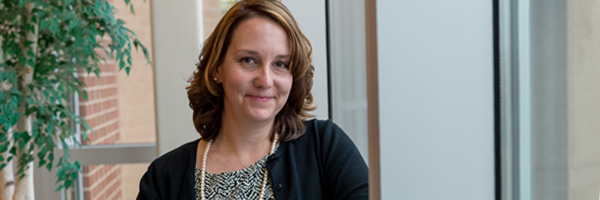May 16

Faculty Members Honored for Making a Difference: Lisa Cooper, Ph.D.
Lisa Cooper, Ph.D., an assistant professor of anatomy and neurobiology, has dedicated countless hours of her time to studying bats. What some might not realize is how many hours she has also spent educating future generations about the winged mammals.
Dr. Cooper’s dedication and achievements were recognized when she was presented the Junior Faculty Award at NEOMED’s Employee Recognition Day on March 27. The award honors a faculty member at the instructor or assistant professor level who has demonstrated exemplary performance in the areas of teaching, research and scholarly accomplishments, and service; and has made a noteworthy contribution to the NEOMED community.
Inspiring tomorrow’s scientists
Not only does Dr. Cooper teach Human Development and Structure to first-semester NEOMED students; she also travels around Northeast Ohio to educate high school, elementary and pre-school students on all things bats.
Most recently, Dr. Cooper traveled to an elementary school in Hudson, Ohio, where she, along with Hope Ball, Ph.D., a postdoctoral fellow in Dr. Cooper’s lab, and Tobin Hieronymus, Ph.D., an assistant professor of anatomy and neurobiology, conducted interactive sessions with hundreds of third-graders.
The trio visits schools around the state to teach children what bats eat, why they have such large wings as babies, how their bodies are structured, and more, depending on the questions they get.
During one of her latest school visits, Dr. Cooper explained to students what our lives would look like without bats. They wouldn’t be too different, right? Wrong. A world without bats and their help would mean lots more mosquitoes and crop pests. Without bats, farmers would collectively have to pay $53 billion dollars a year in pest control.
Bats act as pollinators, explained Dr. Cooper. If there weren’t any bats to pollinate, that would mean a world without some species of banana, mango, cocoa and agave (a natural sweetener used in making tequila).
Bats have bendy bones
While Dr. Cooper’s lab may not resemble the bat cave most people envision (sorry), she uses her spaced tucked away in the walls of NEOMED to study the mechanism of how bats maintain bones that bend during wingbeats, and why bats don’t develop bone fragility.
Still early in her career, Dr. Cooper has already had 33 publications—including four so far in 2018. Dr. Cooper’s research stands out as being integrative and collaborative, noted Amy Lee, M.D. (’88), M.P.H., M.B.A., professor of family and community medicine, before presenting Dr. Cooper’s award at Employee Recognition Day.
For example, a current National Science Foundation (NSF) grant is a collaboration among three investigators at NEOMED and another from the University of Wyoming. Dr. Cooper partners locally with Christopher Vinyard, Ph.D., a professor of anatomy, and Fayez Safadi, a professor of anatomy and neurobiology. The research team is using the NSF grant to study the stiffness and elasticity of the bones of bats compared with terrestrial mammals; how protein signals within these bones shift with age in bats compared with mice; and how the composition of bat bones compares with those of terrestrial mammals at the nanostructure level.
Results of this unique collaboration have generated an impressive mountain of data that links how gene expression, bone cell activity, bone composition and shape determine the unique biomechanical performance of the bendy bones of bats.


